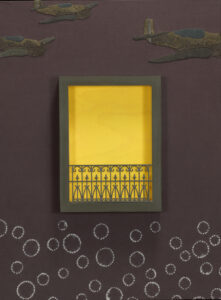In a majority of the artworks in “Lest We Forget,” Minnesota textile artist Sandra A. Brick wanted to feature yellow. In the recess behind a picture frame, Brick paints a bold yellow background for the piece “Bombs Bursting in Air,” emulating the infamous Star of David attributed to Jews in Holocaust-era Germany. Initially, she says, her husband Fred M.B. Amram didn’t like the yellow. But, the piece quickly became one of her favorites in the collection.

“Bombs Bursting In Air” “Three In The Bed” by Fred Amram and Sandra Brick. (Photo by Petronella Janneke Ytsma)
“Bombs Bursting in Air” is one of the numerous 3D multimedia pieces featured in Amram and Brick’s exhibition, “Lest We Forget.” The artworks follow Amram’s childhood experiences in the first moments of the Holocaust, as the husband-wife team take us through his life as a refugee and survivor. Brick compliments her husband’s prose with powerful textile works, featuring family heirlooms and handmade framing. Brick worked closely with her husband, collaborating on numerous artistic projects until his passing early this year.
“We were always interested in each other as people,” Brick notes about their collaborations. “This was just another way of getting to know each other.”
The exhibition can be viewed at the Third Floor Exhibit Gallery at the Minnesota State Capitol through February 29, 2024. The layout of the exhibit is designed by Brick, organized to make viewers feel as if they’re walking through a 3D storybook. Amram’s vignettes are featured in large text by each multimedia piece, which Brick has coined “Reader’s Digest versions” of Amram’s story. The collection initially had nine pieces, then fifteen, twenty, and ultimately twenty-four.
“The location of the exhibit at the Capitol was really important to Fred,” Brick said. “It would have been really grand to have him here.” Unfortunately, the collection’s appearance was postponed due to the COVID-19 pandemic, and Amram did not see the finished exhibition.
In her solo work, Brick has worked with textiles for more than three decades. Her mother was a quilter and she notes that, as she began working with fabrics herself, Brick became “hooked on dying.” For “Lest We Forget,” Brick spent about a year collecting 1930s fabrics to recreate her husband’s memories, hoping to connect with audiences through objects and visuals.
Ultimately, Brick says, “the goal is to ask people to be upstanders.” She probes the audience to ask, what if it were you? believes that this message has become crucial in a post-George Floyd world. “Lest We Forget” can be viewed in rooms 320 and 321 of the Minnesota State Capitol and is free for public viewing. Amram and Brick’s stories can also be explored in their written works, We’re in America Now: A Survivor’s Stories and Lest We Forget: A Visual Memoir. Both books are available in the State Capitol store and on Amazon.




Love reading these passages about the e hibit!
A fantastic and timely exhibit.